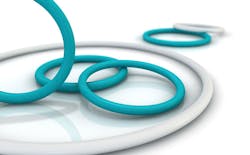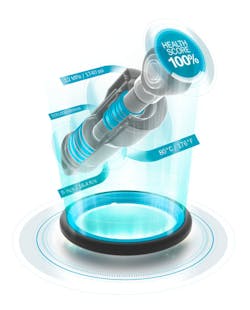Spotlight on Sealing Solutions for Fluid Power and Off-Highway
The coronavirus negatively impacted supply chains and manufacturing industries across the globe. One effect was a decline in demand from end-use industries, such as aerospace, automotive, construction, mining, and oil & gas.
That effect will likely be short-lived as manufacturers build back to serve their customers and as infrastructure funds are unlocked, according to Michael Cook, global segment director, off-highway, and marketing Americas segment manager, fluid power, Trelleborg Sealing Solutions.
Fluid power components and industrial seals support almost every industrial sector where extreme operating conditions set the bar for fluid handling and fluid power applications. Its most important function is to optimize the performance of the machine.
Not surprisingly, enhancements to overall equipment effectiveness (OEE) and turnkey solutions are among top trends in a global fluid power equipment market that was valued at $48.9 billion in 2020, according to recent data.
Given the specialized credentials Cook has amassed since joining Trelleborg in 2013, it seemed only fitting to ask him to provide readers with a finger-on-the pulse overview of the industry he serves.
Rehana Begg: Please tell us about your seals applications experience and how you came to the role you’re in.
Michael Cook: I joined Trelleborg in 2013 as an application engineer focused on our oil & gas segment. I worked with our product management team to propose the best solutions for the extreme applications in that industry. I moved to our fluid power and off-highway segments in 2018 as a technical specialist where I focused on the product strategy for these markets and played a key role in the launch of our AS568 standard O-Rings and the Inch Polyurethane (PU) Product Line for the Americas.
My experience in these segments has provided me with a vision and strategy in my new role as global segment director to ensure we grow our global customer base and continue creating value for our customers. I have also participated in the Trelleborg Graduate Program and the Trelleborg Sealing Solutions Talent Program, both of which helped further my leadership and intrapersonal skills.
RB: Can you comment on notable recent trends in the fluid power and off-highway segments?
MC: After major growth in 2021, the fluid power and off-highway market is set for further growth in 2022 as infrastructure spending is allocated. We continue to see the shift to electrification and integrated use of the Internet of Things (IoT) for next-generation equipment. From a seal supplier standpoint, electrification can change the product mix we recommend for given applications, while the use of IoT provides the impetus to further understand how we can provide real-time feedback on seal performance.
Developing integrated supply partners is another industry focus as the ability to receive kitted or pre-assembled solutions at the C-Part level can ease labor constraints and reduce SKUs and potential installation issues.
RB: What types of seals are most commonly used in the function of hydraulic components in fluid power applications?
MC: Hydraulic systems contain a configuration of seals, each with its own job to perform. In linear hydraulics applications, there are typically rod and piston seals, along with wear rings and wipers. These components can be made from Polytetrafluoroethylene (PTFE) or PU materials.
In rotary hydraulics, common seal types are radial oil seals, cassette seals, mechanical face seals and V-Rings. Many of these seals incorporate rubber or metal components, but PTFE and PU can also be used based on the application.
All hydraulic applications have static seals, with O-Rings being the most common example, and materials being selected based on the temperature and media requirements.
RB: Can you provide a checklist of the considerations needed to select the right seal for an application?
MC: Typically, we need to know the application’s pressure, temperature, speed and media requirements to begin the seal selection process. Another important factor is whether we have existing hardware constraints, or whether we are working with a blank slate and can recommend groove dimensions and surface finish requirements. From there, we can select the seal profile and material that will best handle the given operating conditions and achieve the customer’s targeted lifespan.
RB: What role does the seal supplier play in the design process of customizing components?
MC: A knowledgeable supplier will typically be as hands-on as the customer allows. At Trelleborg, we collaborate with customers in all phases of the design process. We have a wide portfolio of both standard and custom products, as well as hardware and surface finish recommendations, that ensure our products work efficiently while reducing potential customer concerns such as friction or heat generation. Understanding the customer’s primary goal for a given application enables us to use our internal resources and experience to recommend the best solution.
RB: Which quality assurance measures should be employed? Which steps or testing procedures should be followed to control and ensure compliance?
MC: The fluid power and off-highway segments do not have overarching quality assurance standards like one would see in the aerospace and automotive sectors. Many customers have their own standards that we review with our quality team to ensure they can be incorporated into our process if they are not already a standard procedure.
Trelleborg Sealing Solutions is ISO 9001 certified. We have a robust quality management system, which ensures we consistently provide products that meet specified requirements. These requirements can range from 100% inspection to Product Part Approval Processes (PPAPs) or other custom certification packages. Additionally, we make recommendations to our customers regarding safe handling and storage of our products along with best practices for installation to limit the potential for damage.
RB: Consider the term “cognitive sealing.” I understand that this is the term Trelleborg uses to describe predictive maintenance. How is Trelleborg using digitization and IoT strategies—such as sensing, data capturing and AI methods—to interpret the environment around a sealing system?
MC: Cognitive sealing helps companies increase the safety of their machines and applications, while at the same time reducing maintenance and the cost of unexpected downtime.
IoT allows for the remote monitoring of devices and the collection of data. As seals are often critical components within processing systems, cognitive sealing can offer real benefits to manufacturers.
Trelleborg Sealing Solutions has built a team of highly skilled data scientists, electronic engineers and sealing experts who are able to assist in developing condition monitoring solutions. From sensor selection to data analytics and artificial intelligence, we collaborate with customers to develop predictive failure models, build system health dashboards and improve system operation beyond the seals.
RB: What exactly is the “seal health score” and what is involved in analyzing a sealing system?
MC: Several factors influence the health of a seal. By collecting data from the sensors within the application, we can fine-tune our algorithms to account for friction, temperature, pressure and so on. In fact, we take into account external data such as wave height for applications at sea. By deriving the impact on the seal, we can simulate a “health score,” which helps us predict when the seal will fail.
This is only one part of the analysis. We also look at the behavior of the environment to see if there are other signs of degradation in the sealing system. By examining the unique combination of data from various sensors and the complex relationship between them, we can identify patterns or “failure fingerprints.” These enable us to predict not only when a seal will fail but also what type of failure to expect.
Lastly, these systems are not only about failure but also about continuous improvement. Analyzing the data provides actionable insights for future improvements in design and seal selection.
RB: Does Trelleborg incorporate sustainable methods for manufacturing seals? If so, please describe how.
MC: Trelleborg incorporates sustainable methods of manufacturing wherever possible. In addition to optimizing our tooling and machining programs to limit production waste, we “re-grind” material for non-critical components such as wipers and wear rings. Some of our manufacturing plants are also working on eco-packaging initiatives to reduce our plastic usage.
Outside of manufacturing, we use our finite element analysis (FEA) and simulation expertise to predict seal performance and modify our designs prior to any testing, which helps limit prototype loops. Finally, our products provide sustainable options for our customers.
For example, our Lubrication Management program not only extends seal life and reduces scrap—it significantly reduces friction, lowering the energy required to power hydraulic systems and potentially enabling the downsizing of drive components.
About the Author
Rehana Begg
Senior Editor, Machine Design and Hydraulics & Pneumatics

Leaders relevant to this article:




